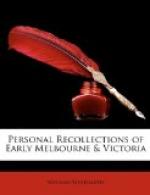THE ABORIGINAL NATIVES IN AND ABOUT TOWN.
“Oh I see the monstrousness of man
When he looks out in an ungrateful shape.”
—Timon of Athens.
The natives still strolled into Melbourne at the time of my arrival, and for a couple of years or so after; but they were prohibited about the time of the institution of the corporation, as their non-conformity in attire—to speak in a decent way—their temptations from offers of drink by thoughtless colonists, and their inveterate begging, began soon to make them a public nuisance. But aboriginal ways did not die at once. The virtues or integrity of native life, as Strzelecki would phrase it, struggled and survived for some few further years the strong upsetting tide of colonial life.
Returning one night, about 1843, from dining with Mr. William Locke, an old colonial merchant, at his pretty cottage and gardens on the Merri Creek, between four and five miles out by the Sydney-road, I diverged westwards from the purely bush track which as yet constituted that main highway of the future Victoria. My object was to escape the swampy vicinities of Brunswick, a village about three miles out of town, consisting for a number of years of three small brick cottages, adventurously rather than profitably built by an early speculator. With firm footing and under a bright moon, I had a pleasant walk through what is now the beautiful Royal Park, when, judging that I must be nearing Melbourne, I perceived quite a number of lights ahead. There were as yet no public lights to scattered little Melbourne in those early days, although the new corporation, elected the year before, had got to work by this time. So, what could it all be? I was not long in suspense. It could only be a native encampment, and I was soon in its midst. The natives at a distance, especially in the far western direction, were still at times hostile, but all those who lived near town were already quite peaceful, so that I had no hesitation in now entering their encampment. I was most cordially received and shown over the different wigwams, each of which had its fire burning. I was taken specially to one occupied by a poor fellow who, under native war laws, had had his kidney-fat wrenched out and eaten by his foes. He showed me the wound, which, however, had now healed up. But he himself had never recovered, being sadly weak and death-like, as one who had but little more to do with this busy world.
The last great native demonstration near Melbourne, and, indeed, so far as I can recollect, the last of its kind within the colony, took place about a mile north-east of the town, in the middle of 1844. This was a grand corrobboree, arranged for amongst themselves by surrounding tribes, including the still considerable tribe of the River Goulburn. This was, as it were, one last aboriginal defiance, hurled in despair from the expiring native cause against




